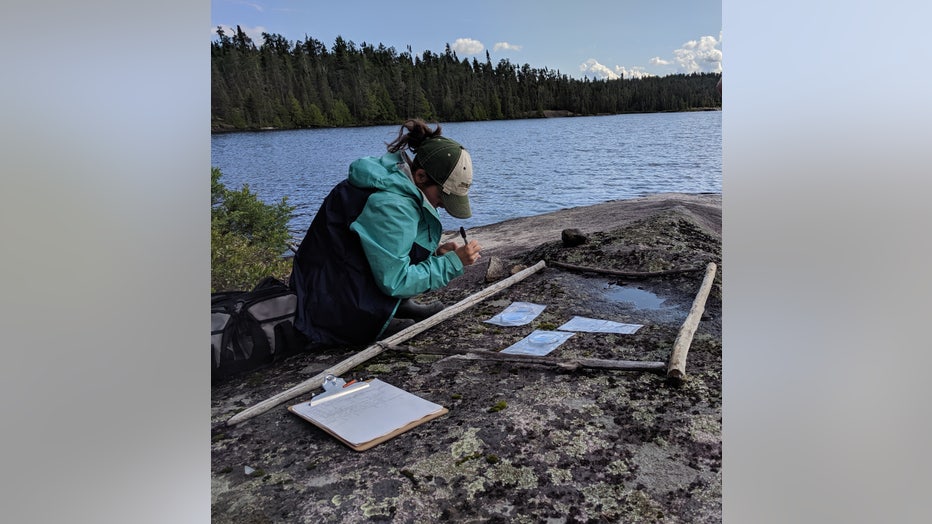Microplastics found in remote waters near Great Lakes in 'alarming' new study

One of nine lakes selected for the microplastics study. Photo courtesy of Haley McIlwraith.
(FOX 2) - By land, by sea, and now by air - microplastics are contaminating the world's most remote locations without the help of people.
The fibers and fragments that shed from clothes and fall off car tires have been found in commercial seafood, drinking water, and in humans. As concerning as the findings are, a new study suggests another troubling conclusion: microscopic plastic particles are reaching corners of the world untouched by people.
That includes remote bodies of water north of the Great Lakes.
Haley McIlwraith, a Ph.D. candidate who authored the study, wasn't surprised to find plastic in each sample they took. However, she was both surprised - and concerned - to find how the contaminants were reaching those sites.
"It's alarming to learn they travel through the atmosphere," she said.
It's not that McIlwraith didn't know the atmosphere played a role in transporting microplastics - it's an observation increasingly confirmed in research about plastic pollution. "We just thought human use made more of a difference."
While McIlwraith is currently based at the Plymouth Marine Laboratory in England, she worked on the study while enrolled at the University of Toronto.

Researchers set up air samplers at one of the nine lakes in the Experimental Lakes Area in Ontario. Photo courtesy of Haley McIlwraith.
The study, published in the Journal of Environmental Toxicology and Chemistry, sought to understand how abundant microplastics were in nine lakes in the International Institute for Sustainable Development—Experimental Lakes Area, which is north of Lake Superior in Ontario, Canada.
It also wanted to find out how the plastics got there in the first place.
Of the nine lakes studied, three were inaccessible by people, three had no human activity but were still used for research, and three were used for recreation.
According to McIlwraith, the concentration of plastic didn't change based on the level of human activity. Instead, "it did point in the direction that the atmosphere was the main pollution pathway," she said.
The atmosphere may be playing a larger role in the spread of microplastics than scientists originally thought.
Microplastics come in many shapes: fibers, films, fragments, foam, and spheres. They're commonly shed from clothes in the wash, eroded from car tires on the road, or found in cosmetics. Wherever those processes happen, microplastics are sure to be found - often in the wastewater treatment process or in food waste.
That's why researchers associated an area's concentration of microplastics with the level of human activity.
But in McIlwraith's study, there was no association. Instead, the particles are getting picked up by the wind and traveling in the atmosphere. They could have been blown from small towns nearby or the Trans-Canada Highway, which runs along the southern portion of the region.
The study's implications are not small - and serve as a reminder of how relatively new the field of study is.
"A lot of people view it as a marine problem since that's where the studies started. But we're discovering it in all systems, terrestrial, air as well," said McIlwraith.
Concluding that the atmosphere plays a major role in spreading microplastics also points to another finding: microplastics have permeated so deeply into our planet, they are behaving like any other water molecule or nutrient.
"They can go from ocean to land, and into rivers and lakes and cycles on through," said McIlwraith.
How far the atmosphere can carry microplastics is also unknown, but it's the smallest fibers that tend to move the furthest. That's another concern because it's the smaller pieces that can have the biggest impact.
"When they get smaller, they can translocate into cells and the bloodstream," Mcilwrait said. "The further they get into the organs in a humans' body, the larger the effect they could have."
MORE: Man who diverted Sleeping Bear Dunes Lakeshore river convicted of 2 misdemeanors
What those effects are is still unclear. Recent studies have suggested having microplastics in the body increases the risk of heart disease and can harm our metabolism and immune system.
Scientists have also seen the impact of microplastics on animals, recording disruptions to their digestive tract, hormone levels, and impaired learning and memory.
Currently, there is a decade-long study happening at one of the water bodies within the experimental lakes area to close the research gaps in microplastics. A better understanding of the physical and chemical characteristics of microplastics will help answer some questions emerging from research like McIlwraith.


